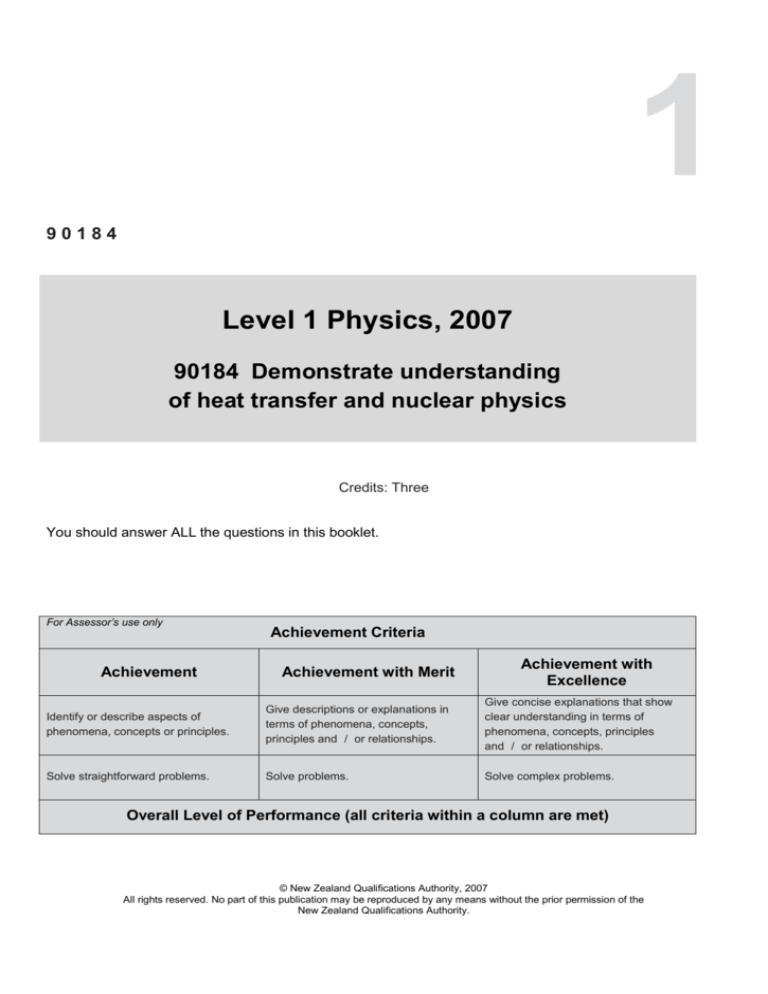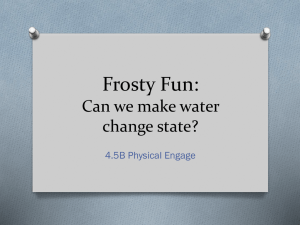
1
90184
Level 1 Physics, 2007
90184 Demonstrate understanding
of heat transfer and nuclear physics
Credits: Three
You should answer ALL the questions in this booklet.
For Assessor’s use only
Achievement
Achievement Criteria
Achievement with Merit
Achievement with
Excellence
Identify or describe aspects of
phenomena, concepts or principles.
Give descriptions or explanations in
terms of phenomena, concepts,
principles and / or relationships.
Give concise explanations that show
clear understanding in terms of
phenomena, concepts, principles
and / or relationships.
Solve straightforward problems.
Solve problems.
Solve complex problems.
Overall Level of Performance (all criteria within a column are met)
© New Zealand Qualifications Authority, 2007
All rights reserved. No part of this publication may be reproduced by any means without the prior permission of the
New Zealand Qualifications Authority.
You are advised to spend 30 minutes answering the questions in this booklet.
You may find the following formulae useful.
QUESTION ONE: NUCLEAR ENERGY
The following equation represents a nuclear reaction.
235
92
(a)
95
U 01 n 42
Mo 139
La 2 01 n X Π01e
57
State what type of reaction this is. Explain your answer.
Reaction type
Explanation
(b)
Calculate the value of X in the above reaction.
value =
(c)
Moderators are an essential part of a nuclear reactor. Name a material used as a moderator in a
nuclear reactor and explain its purpose.
Name
Explanation
The diagram below shows the components inside a power station with a nuclear reactor.
L1 Physics 2007, 90184 – page 2 of 5
(d)
With the aid of the above diagram, explain how electricity is produced continuously in a nuclear
power station.
(e)
The Sun produces energy by nuclear fusion. In a nuclear fusion reaction, a deuterium nucleus, 1H, and
3
a tritium nucleus, 1H, are fused together to form a helium nucleus and a neutron.
2
Write a balanced equation for the above fusion reaction.
(f)
Energy is radiated from the Sun at a rate of 3.8 × 1026 W. Burning 1.0 million tonnes of coal releases
3.0 × 1016 J of energy.
Calculate how many million tonnes of coal would need to be burned each second to match the Sun’s
power.
amount =
(g)
Most of the energy released by the Sun is in the form of radiation.
Explain why no heat escapes into space by conduction or convection.
QUESTION TWO: THE ICE RINK
Ice rinks are designed using the idea of heat transfer, which keeps a large area of ice cold, even on hot
summer days. Under the ice floor, there are pipes that carry salt water. The pipes are connected to a
refrigeration unit, which constantly removes heat from the salt water and keeps the ice cold.
http://studentblog.registrar.ualberta.ca/umidjon/DSCF0999.JPG
As the cold salt water passes through the refrigerator, the liquid in the refrigerator absorbs the heat from the
salt water and changes to gas.
(a)
Latent heat of vapourisation of the refrigerator liquid is 139 000 J kg–1.
Calculate the energy lost by the salt water when 8.0 kg of the refrigerator liquid changes to gas.
energy =
(b)
In a rink, the ice stays frozen and yet the air around the spectators looking down on the rink is quite
warm.
Explain why the air around the spectators is warmer than the air just above the ice.
L1 Physics 2007, 90184 – page 3 of 5
To renew the damaged ice surface, machines scrape the top layer of the ice flat. Warm water is then poured
onto the surface and the water freezes to make the surface smooth again.
(c)
On one occasion, the machine scrapes 75 kg of ice and dumps it outside of the building.
Calculate the amount of energy needed to convert the ice at – 4.0°C to ice at 0°C.
Specific heat capacity of ice is 2 100 J kg–1 (°C)–1
energy =
For questions (d) and (e), use the following data.
Specific heat capacity of water = 4 200 J kg–1 (°C)–1
Specific heat capacity of ice = 2 100 J kg–1 (°C)–1
Latent heat of fusion of ice = 340 000 J kg–1
(d)
The heater in the machine warms 300 kg of water from 15°C to 50°C. The electric heater has a power
output of 8.5 kW.
Calculate the time taken for the heater to warm 300 kg of water from 15°C to 50°C.
time =
(e)
300 kg of water at 50°C is now poured on to the ice to make the surface smooth again.
Calculate the amount of energy that must be removed from the water to turn it into ice at 0°C.
energy =
QUESTION THREE: THE ROOF
On sunny days the metal roof of the ice rink gets very hot. To prevent the heat melting the ice, a thick layer
of insulating material is fitted under the roof and held in position by sheets of shiny aluminium foil.
L1 Physics 2007, 90184 – page 4 of 5
(a)
Use your knowledge of methods of heat transfer to explain how the above-mentioned roofing design
will aid to keep the temperature steady inside the rink.
(b)
On a sunny day, each square metre of the earth’s surface receives 65 W of radiation from the sun.
Show that the energy reaching one square metre in one hour is 234 000 J.
(c)
The iron roof absorbs only 12% of 234 000 J. The mass of one square metre of the iron roof is 4.3
kg. The temperature of the roof increases by 14.5°C during one hour.
Calculate the specific heat capacity of the iron roof.
specific heat capacity =
L1 Physics 2007, 90184 – page 5 of 5










